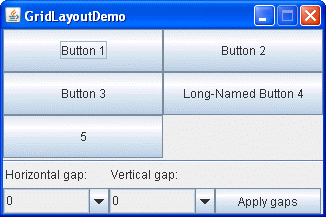Lesson: Laying Out Components Within a Container
Java 教程是为 JDK 8 编写的。本页中描述的示例和实践未利用在后续版本中引入的改进。
如何使用 GridLayout
注意: This lesson covers writing layout code by hand, which can be challenging. If you are not interested in learning all the details of layout management, you might prefer to use the
GroupLayout layout manager combined with a builder tool to lay out your GUI. One such builder tool is the NetBeans IDE. Otherwise, if you want to code by hand and do not want to use GroupLayout, then GridBagLayout is recommended as the next most flexible and powerful layout manager.
If you are interested in using JavaFX to create your GUI, see Working With Layouts in JavaFX.
The following figure represents a snapshot of an application that uses the
GridLayout class.

Click the Launch button to run GridLayoutDemo using Java™ Web Start (download JDK 7 or later). Alternatively, to compile and run the example yourself, consult the example index.
The complete code of this demo is in the
GridLayoutDemo.java file.
A GridLayout object places components in a grid of cells. Each component takes all the available space within its cell, and each cell is exactly the same size. If the GridLayoutDemo window is resized, the GridLayout object changes the cell size so that the cells are as large as possible, given the space available to the container.
The code snippet below creates the GridLayout object and the components it manages.
GridLayout experimentLayout = new GridLayout(0,2);
...
compsToExperiment.setLayout(experimentLayout);
compsToExperiment.add(new JButton("Button 1"));
compsToExperiment.add(new JButton("Button 2"));
compsToExperiment.add(new JButton("Button 3"));
compsToExperiment.add(new JButton("Long-Named Button 4"));
compsToExperiment.add(new JButton("5"));
The constructor of the GridLayout class creates an instance that has two columns and as many rows as necessary.
Use combo boxes to set up how much vertical or horizontal padding is put around the components. Then click the Apply gaps button. The following code snippet shows how your selection is processed by using the setVgap and setHgap methods of the GridLayout class:
applyButton.addActionListener(new ActionListener(){
public void actionPerformed(ActionEvent e){
//Get the horizontal gap value
String horGap = (String)horGapComboBox.getSelectedItem();
//Get the vertical gap value
String verGap = (String)verGapComboBox.getSelectedItem();
//Set up the horizontal gap value
experimentLayout.setHgap(Integer.parseInt(horGap));
//Set up the vertical gap value
experimentLayout.setVgap(Integer.parseInt(verGap));
//Set up the layout of the buttons
experimentLayout.layoutContainer(compsToExperiment);
}
});
The GridLayout API
The following table lists constructors of the GridLayout class that specify the number of rows and columns.
| 构造函数 | 目的 |
|---|---|
GridLayout(int rows, int cols) |
Creates a grid layout with the specified number of rows and columns. All components in the layout are given equal size. One, but not both, of rows and cols can be zero, which means that any number of objects can be placed in a row or in a column. |
GridLayout(int rows, int cols, int hgap, int vgap) |
Creates a grid layout with the specified number of rows and columns. In addition, the horizontal and vertical gaps are set to the specified values. Horizontal gaps are places between each of columns. Vertical gaps are placed between each of the rows. |
The GridLayout class has two constructors:
Examples that Use GridLayout
The following table lists code examples that use the GridLayout class and provides links to related sections.
| 例子 | Where Described | Notes |
|---|---|---|
GridLayoutDemo |
This page | Uses a 2-column grid. |
ComboBoxDemo2 |
如何使用组合框 | One of many examples that use a 1x1 grid to make a component as large as possible. |
LabelDemo |
如何使用标签 | Uses a 3-row grid. |